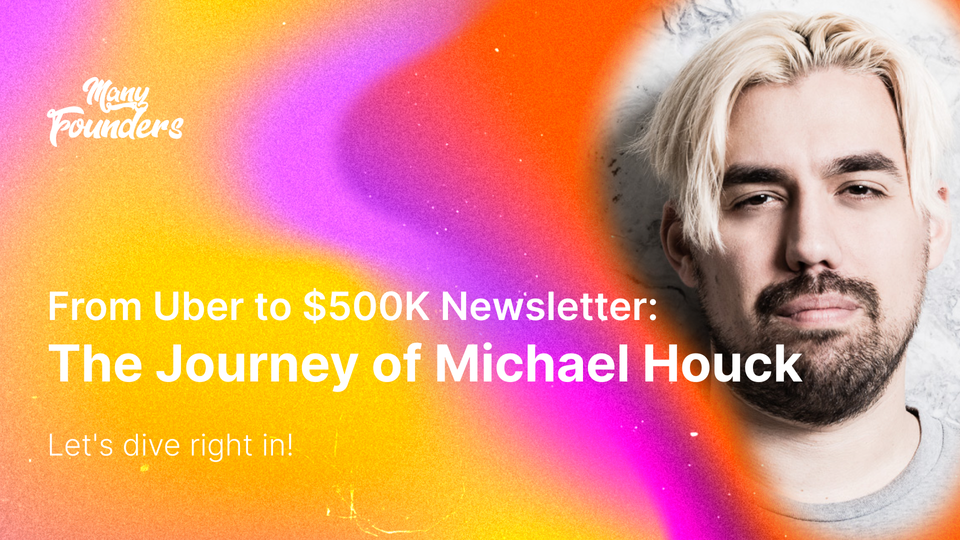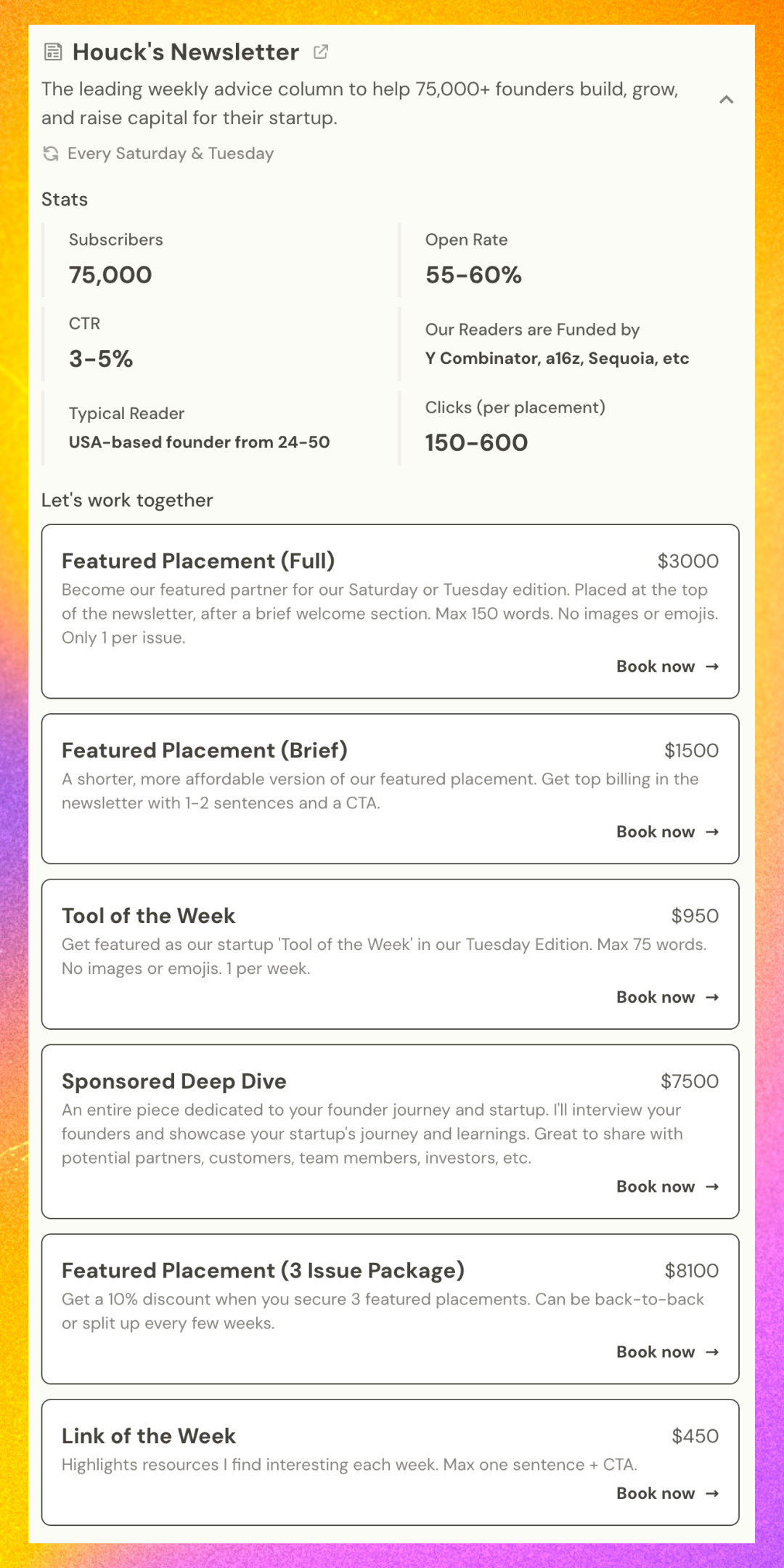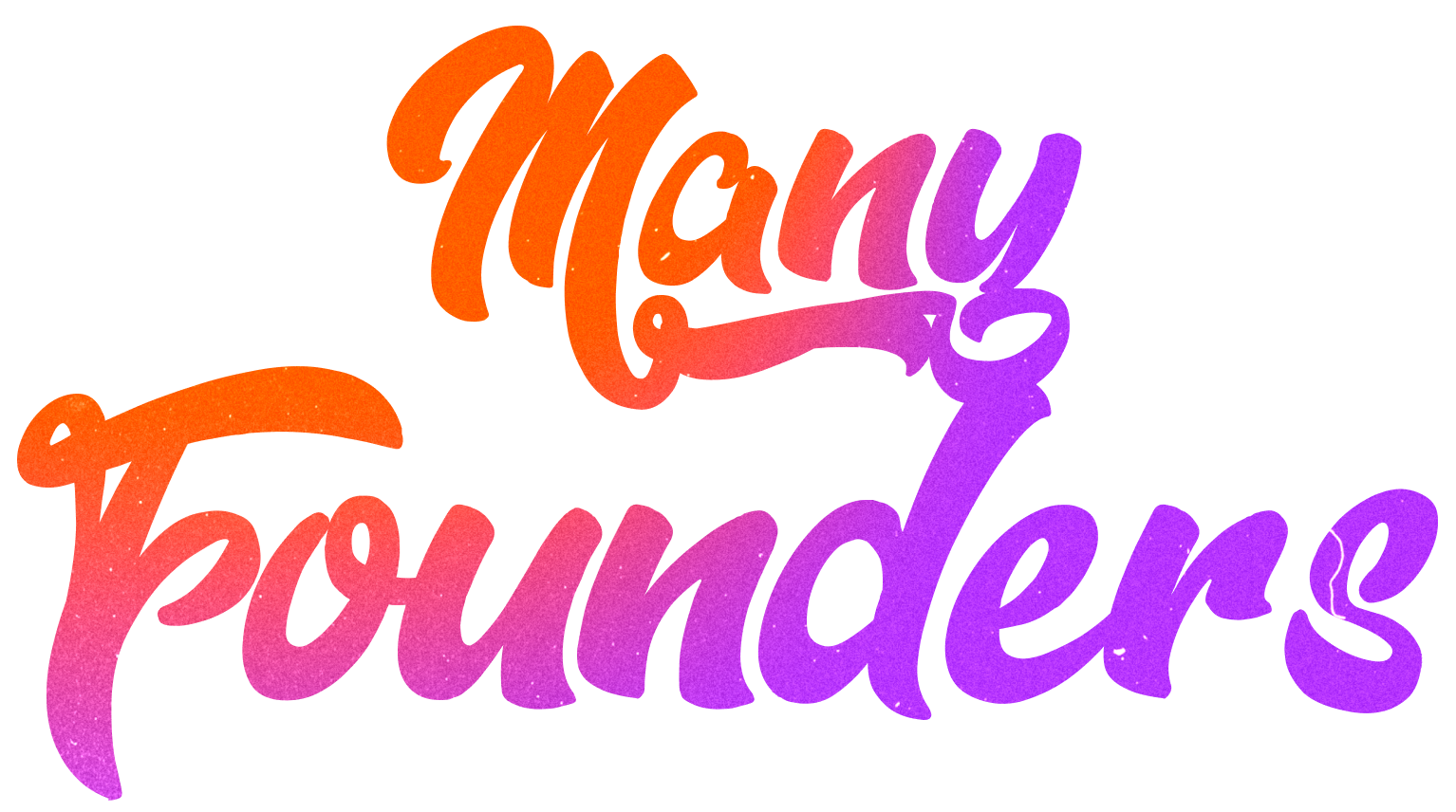How Did Michael Houck Turn Uber Driving into a $500,000 Newsletter Empire in Just One Year?

Today's hero is Michael Houck. Not so long ago, he was driving for Uber to pay his bills, but by now, he has managed to work for large companies such as Uber Eats (it's probably amusing to be on both sides of the Uber corporation) and Airbnb. He also launched a startup in which one of the largest funds, Andreessen Horowitz, invested. Moreover, he created his own venture fund and invested in more than 50 early-stage companies.
However, with such a powerful background, Michael decided to focus on his email newsletter, where he shares his experience with fellow startup founders, helping them build companies and raise investments.
His newsletter is simply called Houck's Newsletter, and in 2023, it generated over $500,000 in revenue. According to Michael's forecasts, it should bring in 3–4 times more in 2024. In today's story, we'll explore how Michael managed to grow to more than 90,000 subscribers and generate half a million in revenue in the first year of launching the project.
The Story
As I mentioned earlier, Michael worked at Uber Eats as a data analyst before moving to Airbnb, where he led a product team. During the COVID-19 pandemic, he was laid off, and it was then that he decided not to return to a corporate career and instead pursue his dream of building startups.
He managed to grow a startup to $3,000,000 in revenue and secure investments from the largest funds in Silicon Valley. Furthermore, Michael founded his own venture fund, which invested in more than 50 companies, many of which are quite successful at the moment.
Back in 2022, Michael already had a small audience of founders and startup enthusiasts on Twitter, and he was running his newsletter as a side project. However, standing at a crossroads of what to do next—whether to delve into studying AI or try to devote all his time to the newsletter and see what could happen—Michael chose the latter.
Just hit 50,000 friends on here so time to reintroduce myself.
— Michael Houck 💡 (@callmehouck) December 13, 2023
I’m Michael Houck 👋
10 years ago I dropped out of film school and decided to build startups.
I had no network in tech and no money. It was scary — I failed a lot for a couple years and drove for Uber to pay rent.…
What's under the hood of Houck's Newsletter?
To begin with, I'd like to talk about email newsletters in general, which are experiencing a second peak. Among the founders of this trend are projects like The Hustle, which was bought by HubSpot for an impressive sum of around $27,000,000 in 2021, and Morning Brew, sold to NYT for 5 million. The audience, or rather the audience's attention, is the real oil and gold in one package in the era of ubiquitous online presence.
Michael rode this trend. His newsletter has 2 issues per week: the first is free for all subscribers, where he shares his experience in creating and launching startups, their development, and attracting investments. Michael monetizes this through the sale of advertising and sponsorships.
Here's what the prices for advertising slots in the free newsletter look like:

The second issue is for premium subscribers, where he analyzes in detail various aspects related to startups, such as fundraising, leadership and management, growth hacking, and others. The subscription to the premium part costs 15 bucks a month, and in addition to the weekly deep dives, users also get access to a closed community of founders.
As Michael himself says, the audience of founders and startup enthusiasts is a high-value audience, which allows for maintaining a high CPM for advertisers. This is a significant part of the project's financial success. Moreover, Houck's Newsletter has excellent engagement: the open rate reaches 59%, which is an excellent indicator for the newsletter market and a big plus for brands buying sponsorship packages.
Apart from advertising and subscriptions, Michael earns money through paid consultations and attracting clients to his project, Megafon, which we will discuss separately.
Michael's Unique Approach
Michael's results look very impressive, and there are, of course, quite logical reasons for this. The main one is Michael's unique approach to the project.
I think coming to a Creator business from a venture-backed startup as a Founder in particular was a huge Advantage
Michael initially built the newsletter as a startup, which favorably distinguished him in the creator space. He quickly tests many hypotheses and scales the most successful ones. He invests all the profits received into paid traffic acquisition channels and is always focused on increasing profits and keeping costs as low as possible.
In addition, one of the key factors of his success is that he deeply engaged the audience at various points of contact: emails, Twitter, LinkedIn. From the very first step, he communicated with the community to understand what really concerns them and how to solve these issues in the best way possible.
So how does Houck's Newsletter attract subscribers?
Now we've come to the most interesting part. And in the case of Houck's Newsletter, we really have something to talk about.
1 - Twitter (X)
1.1 - Networking
If there's one thing Michael is really good at, it's Twitter. As I mentioned above, by the time he decided to fully engage in the newsletter all the time, he already had a small audience of entrepreneurs on Twitter, which helped him not start from scratch completely. In addition, Michael's network and acquaintances also provided him with a big boost on Twitter.
Here's how it works:
For Twitter, it's important to know what reaction your post will get in the first few minutes after publication. This is what determines whether your content will go viral. What do you think will happen if, in the first few minutes, your post is liked, commented on, and retweeted by large accounts with tens or even hundreds of thousands of followers? That's right, an explosion of views and, as a result, a ton of new subscribers.
As Michael himself says, thanks to his network, he had access to closed creator chats where guys who already had a large audience hung out. They would drop links to their posts in the first few minutes after publication and support each other with likes, comments, and retweets.
Great technique! This very mechanism will become the basis of Michael's startup, which he is developing in parallel with the newsletter. But more on that later.
1.2 - Lead Magnets
Of course, Michael's approaches to promotion on Twitter are not limited to one trick. The next approach helped him gain about 15,000 new subscribers in just 6 weeks in the spring of 2023.
Michael organized lead magnet giveaways. These were databases, article summaries, and other useful content. But we are much more interested in the process of obtaining such content than the content itself.
Here's what one of the posts looked like:
Want to learn more about startups?
— Michael Houck 💡 (@callmehouck) March 3, 2023
I used ChatGPT to summarize over 1,300+ articles and blog posts from:
→ Y Combinator
→ Marc Andreessen
→ Paul Graham
→ Sam Altman
And 20+ more leaders
Retweet & reply "GPT" and I'll DM you a database with them all
(Must be following) pic.twitter.com/st9bTE2Aza
To gain access to the content, it was necessary to subscribe to Michael's Twitter account and retweet the post. Then you will receive a link to where the content is located.
And here's the kicker: To download the promised content, you need to register. Thus, you also end up on Michael's email newsletter list. Two for one, not bad, right?
Michael bought ads for such content giveaway posts in order to reach as many people as possible.
2 - Newsletter Acquisitions
Remember when I said that Michael approaches the newsletter as a startup? Well, here's another great proof. Already in the early stages of the project, Michael bought several smaller newsletters with a similar audience and integrated their audience into his own.
The sale amounts are, of course, unknown. However, in the first one - Daily Dose of Startups - there were just over 2,000 subscribers at the time of purchase.
Many in the creator space wouldn't even consider buying newsletters with a similar audience. But Michael was able to correctly use his startup background here as well and quickly get a good boost of a high-quality and relevant audience.
3 - Paid Advertising
Another important traffic channel for Houck's Newsletter was paid advertising on Twitter, LinkedIn, and Spark Loop. And there's no rocket science here that clients and subscribers can be obtained from paid advertising. But I want to mention this for several reasons.
3.1 - The approach to paid advertising itself
Michael began testing paid traffic channels right after the big boost of 15,000 subscribers on lead magnets, because that's when sponsors actively started buying advertising slots, which began generating significant revenue for Michael. He started investing this very revenue into paid channels.
At first, Michael launched ads on his own, and after gaining experience, he delegated them to Matt McGarry's agency, well-known among creators of news newsletters, which specializes in attracting subscribers to news newsletters.
3.2 - SparkLoop
This platform is unlikely to be so well-known outside the creator space, which is exactly why I decided to mention it separately. SparkLoop allows you to attract subscribers through recommendations in other newsletters and through a referral system. And, most interestingly, you pay not for clicks or impressions but for those who subscribe to your newsletter.
It's a great niche channel, in which Michael invested more and more each month, as he himself repeatedly admitted in interviews.
However, it would be fair to mention what Michael himself noted: the quality of subscribers, namely the open rate and read-through rate of emails, from paid advertising is noticeably lower than from organic traffic.
Megaphone
Finally, we got to megaphone. As I mentioned above, at the start of the newsletter, Michael used the help of colleagues and acquaintances who already had an audience to develop his account through interaction with popular accounts.
What if an analogue of such a closed chat with top creators was available to everyone who wanted to promote themselves on Twitter? This is the idea behind the Megaphone startup.
How does it work? You buy a subscription and get access to a base of Twitter creators with an audience. Then you make a deposit, post content, and Megaphone creators who were online in the first hour after publication interact with the content, letting Twitter know that you and your content are worth paying attention to, making it viral.
You got attention, the creators who interacted with the content got money, and Megaphone got the subscription cost and commission. And pay attention: if in the lead magnet giveaway Michael used a double subscription (both to the account and to the newsletter), then here there is double monetization: both a subscription for access to the service and a commission for the very interaction of creators with the content. Smart!
2023 stats for Megaphone:
— Michael Houck 💡 (@callmehouck) January 1, 2024
→ 502 signups
→ 2,133 posts amplified
→ 6,944 boosts by creators
→ $44,886 earned by creators
→ 53 million impressions generated
→ 416,229 followers gained by users
MVP launched in August after a short beta.
2024 is going to be even bigger.
Currently, Megaphone has only 250 users and just over a hundred creators who have a total of about 11 million subscribers and generate 20,000,000 views. Megaphone creators are followed by big "guns" from Silicon Valley, for example, the founders of Andreessen & Horowitz.
Why did I decide to mention Megaphone?
The ecosystem is another part of Michael's startup approach. And Megaphone is another link in this ecosystem.
The newsletter for Michael is an entry point into the ecosystem. It already has a community for premium members, where Michael, among other things, helps founders find investments, and I'm sure sooner or later it will become something like a startup accelerator.
The ecosystem already has the Megaphone startup, and according to Michael, this is most likely far from the last startup that will be launched, including for the audience of his newsletter. And all this was built in just over a year. Again, at the speed of a good startup.
Conclusion
I hope you enjoyed this not entirely ordinary story of Houck's Newsletter, and you were able to trace how the very startup approach in the newsletter market, which is very different from the venture one, was noticeable through all of Michael's actions like a thin thread.
I think this story perfectly shows how you can intelligently use your background in a fundamentally new space and market, achieving outstanding results.
Here, in my opinion, are the main factors of Michael's success that are worth your attention:
1 - The startup approach. Undoubtedly, this is an important key to the result. An important part of the whole puzzle.
2 - Using connections and network at full power
3 - Quick testing of hypotheses and rapid scaling of the most successful ones
4 - Reinvesting profits back into the project to accelerate growth
5 - The approach to building not just a newsletter, but an ecosystem based on the newsletter audience
I think it was useful. Until new issues!

Member discussion